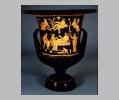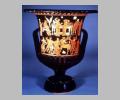
Side A, lower frieze: Peirithoos, Laodameia, Centaur, Theseus

Side B: overview
[Image not available]
Three-dimensional approximation of the vase

Side A: overview

Side A, upper frieze: old man, standing woman at right

Side A, upper frieze: old woman, seated woman, Eros at left
| Collection: | London, British Museum |
| Summary: | Side A: Centaurs at the wedding feast of Peirithoös, the lovesickness of Phaidra Side B: Dionysos with satyrs and maenad |
| Ware: | Apulian Red Figure |
| Painter: | Attributed to the Laodamia Painter |
| Attributed By: | A.D. Trendall |
| Context: | From Anzi |
| Date: | ca. |
| Dimensions: | H. 0.762 m. |
| Primary Citation: | |
| Shape: | Calyx krater |
| Region: | Basilicata |
| Period: | Late Classical |
Decoration Description:
Side A: The upper register depicts what might be the lovesickness of Phaidra. In the center is a large couch, the legs of which are inlaid with palmettes, volutes, and Gorgoneia, while along the front are spirals and other patterns. On the couch is a mattress with a lozenge pattern and an embroidered purple cushion at each end. Beneath it is a large low stool with inlaid patterns in white, yellow, and purple. In front of the couch are two female attendants who stand facing each other. The attendant on the left holds up a large white fan in her right hand, and extends her left to to the other woman, whose hands are placed behind her head. The first wears earrings, a double necklace, a long chiton and overblouse which falls to her hips. She also has sandals, and her hair is gathered under a close-fitting cap. The other wears earrings, a double necklace and long, transparent chiton. She has shoes, and her hair rises in a mass over her forehead and falls loosely on her shoulders. On the left is Phaidra, seated on a four-legged cushion to the right, with a downcast face. Her legs are crossed, and her hands are clasped on her right knee; her feet rest on a footstool. Her hair is gathered up under a veil, and she wears earrings, a double necklace, bracelets, a long chiton, and sandals. Behind her and above her head hangs a sistrum tied with a purple fillet. Before Phaidra hovers Eros to the left, represented on smaller scale with long hair and sandals, holding out a fillet. Behind Phaidra is a nurse standing to the right, with white hair, a long girt chiton and himation. The nurse's right hand supports her chin, and her left is extended. On the right is a paidagogos standing to the right, with white hair and a beard, a short girt chiton, bordered himation, high boots with white tops turned out, and a crook in his left hand. His right hand is extended as if he were conversing with the female figure facing him. She wears earrings, a necklace, a veil, a long chiton and himation. Her right hand is placed under her chin. Above, behind the paidagogos, hangs a cista, on which are painted human figures in white.
The lower register of Side A depicts the combat between the Lapiths and the Centaurs at the wedding feast of Peirithoös. A centaur advances from the right, wearing a wreath and panther-skin draped over his shoulders and knotted in front. He carries a branch in his left arm, and seizes Laodameia by the left arm and around her neck. She has just stepped down from a chair, which has very ornamented legs and a cushion (similar to the couch decribed above). Laodameia has long hair and wears a diadem, earrings, triple necklace, long transparent embroidered chiton, and sandals. Her right foot is placed on a footstool, and she looks back at Peirithoös, who advances and seizes the centaur's right arm. He is nude and beardless, with short curly hair, a chlamys thrown over his left arm, and a sword in the right. Above each of them their names are inscribed:
Side B: In two scenes, Dionysos reclines on a couch, surrounded by his followers. On the upper level in the center of the composition, a youthful Dionysos is seated to the left, looking back. He wears a fillet, anklets, sandals, and his drapery is thrown down beneath him. He holds a phiale in his right hand,and a thyrsos head downwards in his left. Above him is a cluster of grapes, and on the left a tree. Beyond the tree is a female figure seated to the left, looking back. Her hair is tied in a knot with string, and she wears a radiated open cap, double necklace, a bracelet on her right arm, a long girt chiton fastened on the shoulders, and sandals. She holds a thyrsos in her right hand tied with a fillet, and a wreath in her left. On the right is a similar female figure, looking back (she wears a bracelet on her left arm, no girdle, and a tympanon in her left hand).
On the lower level, Dionysos reclines to the left on a kline with embroidered hangings in the center of the composition. He is beardless, with long hair, a wreath, and a himation over his lower body. His left leg is doubled up under him, and he rests his left elbow on a purple embroidered cushion and holds a white kantharos in his other hand. At his feet, a female sits on the kline, facing him. Her hair is tied back with a string under an open cap radiated in front, and she wears a double necklace, bracelet on her left arm, a long chiton, a himation over her lower limbs, and sandals. On her lap is a tympanon, and in her right hand she holds out a small white prochoös. Behind her is a youthful satyr, wearing a fillet, carrying a large krater with both hands. It is fluted at the top and bottom, and has three human figures painted on it, in white and yellow. In front of the couch is Pan, represented in smaller scale, beardless, and with goat's legs. He moves to the left, with a branch in his right hand, and a dish of fruit in his left. Behind him to the right is an incense burner. Behind Dionysos stands a female figure with hair as the last, wearing earrings, a necklace, bracelets, a long chiton, and an overblouse. She holds up a wreath in her right hand to crown Dionysos, and in her left is a thyrsos.
Above the scenes, along the rim, is a laurel wreath. Below, the vase is fluted
Collection History:
Fittipaldi Collection, afterwards in possession of Prince Napoleon Bonaparte.
Sources Used:
Funerary Symbolism in Apulian Vase-Painting (Berkeley, 1976) 187-188
Other Bibliography:
Zur griechischen Vasenmalerei des 6. bis 4. Jahrhunderts vor Christus (Halle 1952) fig. 45Antike und Abendland 10 (1964) pl. 2, fig. 4Who's Who in Classical Mythology (London 1973) 330